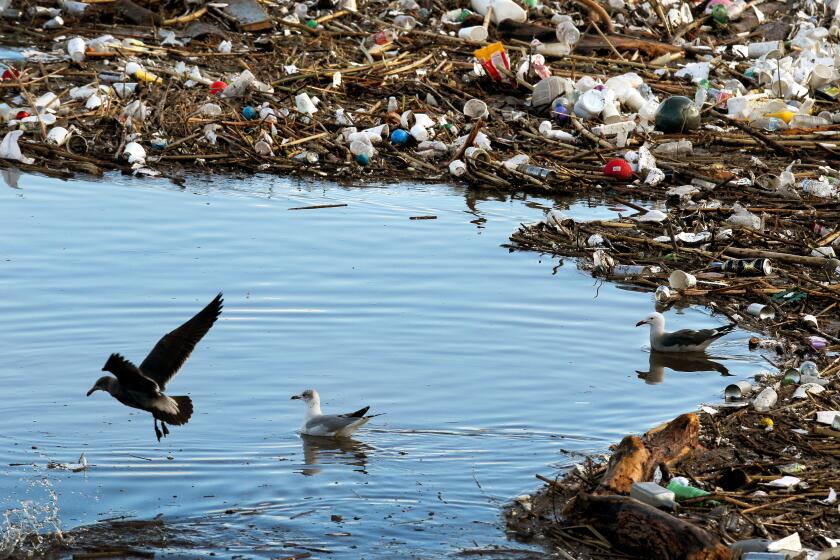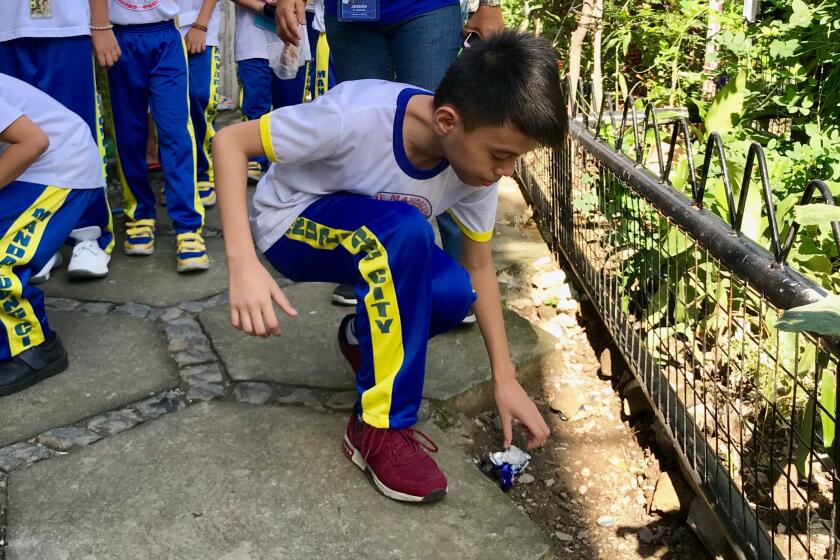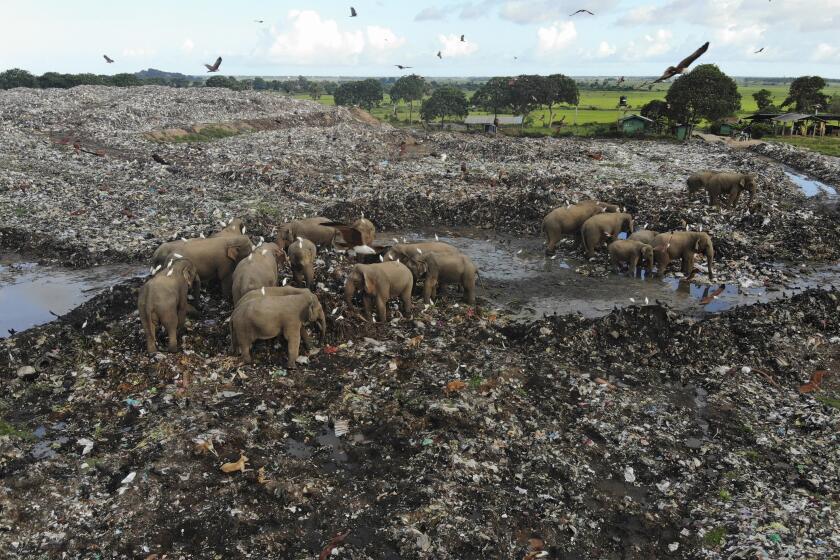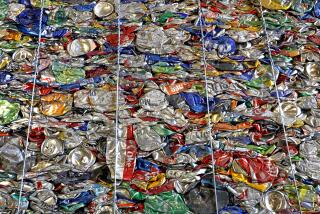Trick or trash: What to do with tons of Halloween candy plastic waste

- Share via
Halloween treats have a tricky problem: plastic packaging that’s difficult to recycle.
As America loaded up on an estimated 600 million pounds of candy for Halloween, a handful of companies tried to make it easier to recycle all of those wrappers. But they acknowledge that their efforts make only a small dent and say more fundamental changes are needed.
Since the beginning of October, Mars — the maker of Snickers and M&Ms — has distributed 17,400 candy waste collection bags to U.S. consumers through its website and at community events. The bags can be filled with wrappers and packaging from any brand and mailed free to a specialty recycler in Illinois. That recycler, G2 Revolution, forms the packages into pellets and uses them to make waste bags for dogs.
The bags fit about 4 ounces of material; if all 17,400 are returned, that will equal more than 2 tons of recycled wrappers. But even then, the recycling program would still address only a tiny fraction of the problem.
“What I’d like to see is this program actually goes away over time and we have a solution where it’s no longer required and we’re fully recyclable,” said Tim LeBel, president of sales for Mars Wrigley U.S.
Mars is partnering with Rubicon Technologies, a Lexington, Ky., consultant and software provider that connects companies and municipalities to recyclers. Since 2019, Rubicon has had its own program called Trick or Trash, which mails one free box to schools, businesses and community groups to collect candy wrappers for recycling. An additional box, or a box for personal use, is $100; Rubicon says that covers the cost of making the box, shipping it both ways and recycling the wrappers. Rubicon expects to send out 5,000 boxes this year.
Environmentalists and industry are at odds over a November ballot initiative that would reduce single-use plastics and polystyrene food containers.
Mars and Rubicon won’t say how much they’re spending on their Halloween programs. Rubicon notes that it pays extra to UPS to offset the carbon emissions from shipping.
Plastic wrappers are ideal for candy for lots of reasons. They’re cheap and lightweight, which cuts down on shipping costs, said Muhammad Rabnawaz, an associate professor in the school of packaging at Michigan State University. They’re also easy to modify for different functions; some might have a coating so candy doesn’t stick to them, for example.
But plastic wrappers are a challenge for recycling companies. They often contain a mix of materials, including foil, which must be separated. They’re small and flimsy, making it easy for them to bypass typical sorting equipment. They have to be cleaned to remove grease, oil and other food waste. They’re multicolored, so when they’re mixed together they come out as an unappealing brown.
Even when companies do go to the effort of recycling candy wrappers, they produce such a low-value plastic that it doesn’t recoup the cost of recycling.
Single-use sachets have helped low-income consumers but cannot be easily recycled, and are spilling into the oceans.
“It’s got to be profitable. These guys aren’t social workers,” said Brandon Wright, a spokesman for the National Waste and Recycling Assn., which represents waste management companies.
As a result, a lot of plastic packaging ends up being thrown away. According to the U.S. Environmental Protection Agency, containers and packaging made up 21% of trash going into landfills in 2018.
That’s why it’s critical to have food companies or individual consumers funding recycling efforts, said Tom Szaky, the chief executive of TerraCycle.
The New Jersey-based recycling company recycles candy wrappers in Britain through partnerships with Nestle and Ferrero. In the U.S., the company will ship boxes to consumers to collect candy and snack wrappers and return them for recycling. A small box is $86; a large one is $218. TerraCycle said that covers the cost of shipping and the multipart recycling process.
Activists worry that all those coronavirus masks, medical kits, takeout containers and grocery bags are setting back a global fight to curb single-use plastic.
Szaky said TerraCycle has recycled about 40 million candy wrappers worldwide since 2014.
Leah Karrer, a conservationist in Washington, bought a TerraCycle box in 2020 and collected 5 pounds of Halloween candy wrappers from about 20 neighbors. She liked raising awareness about the problem and supporting TerraCycle, but she hasn’t done it again because the box was so expensive.
“This is not a cost-effective solution for most families, when the items can simply be thrown into a trash container to be picked up for free,” she said.
This year, she ordered a free bag from Mars, so that she can send a message that consumers care about plastic waste and want companies to switch to sustainable packaging.
Toward a more sustainable California
Get Boiling Point, our newsletter exploring climate change, energy and the environment, and become part of the conversation — and the solution.
You may occasionally receive promotional content from the Los Angeles Times.
“The onus cannot be on the customer to fix the massive plastic waste problem,” she said. “The solution is system change.”
Candy makers say they’re spending millions to develop new packaging that would be easier to recycle or compost.
Mondelez’ International’s Cadbury introduced more easily recyclable packaging — made of 30% recycled plastic — in some markets this year. Mars recently partnered with Danimer Scientific, a biotech company, to develop compostable packaging. Hershey has set a goal of making all its packaging easily recyclable, reusable or compostable by 2030.
The National Confectioners Assn., which represents the candy industry, says governments also need to invest in more advanced recycling.
Conservationists and veterinarians are warning that plastic waste in an open landfill in eastern Sri Lanka is killing elephants.
But Janet Dominitz, the executive director of the Massachusetts Public Interest Research Group, said recycling alone will never keep up with the amount of packaging waste. Dominitz said single-use plastic packaging needs to be eliminated.
“The problem isn’t the number of candy wrappers on Halloween, but the 365 days a year that our infrastructure is set up to throw [things] away,” she said.
More to Read
Sign up for Essential California
The most important California stories and recommendations in your inbox every morning.
You may occasionally receive promotional content from the Los Angeles Times.













